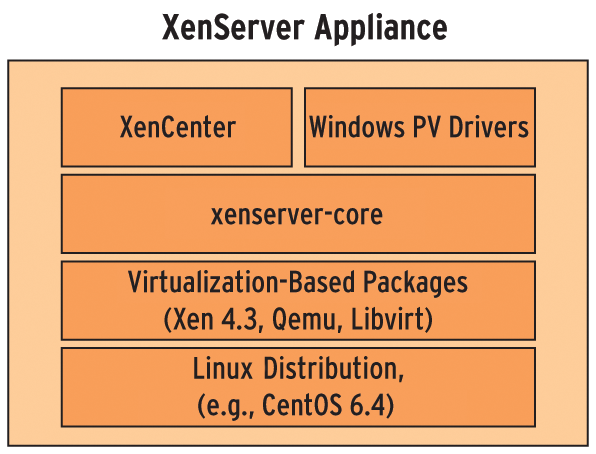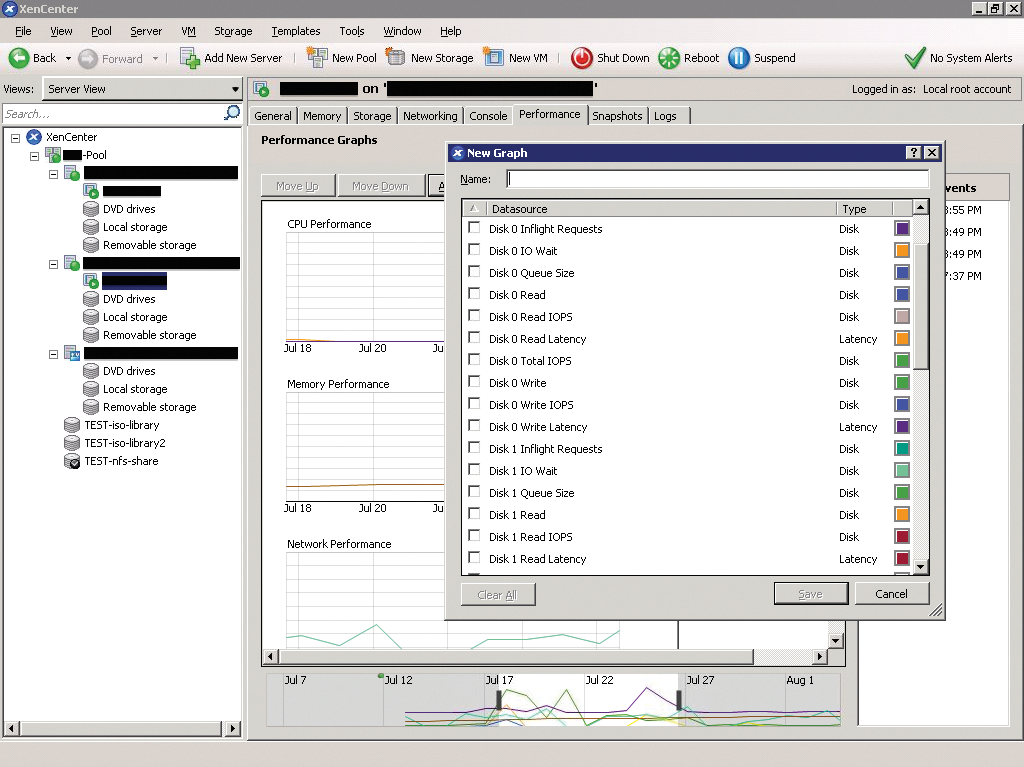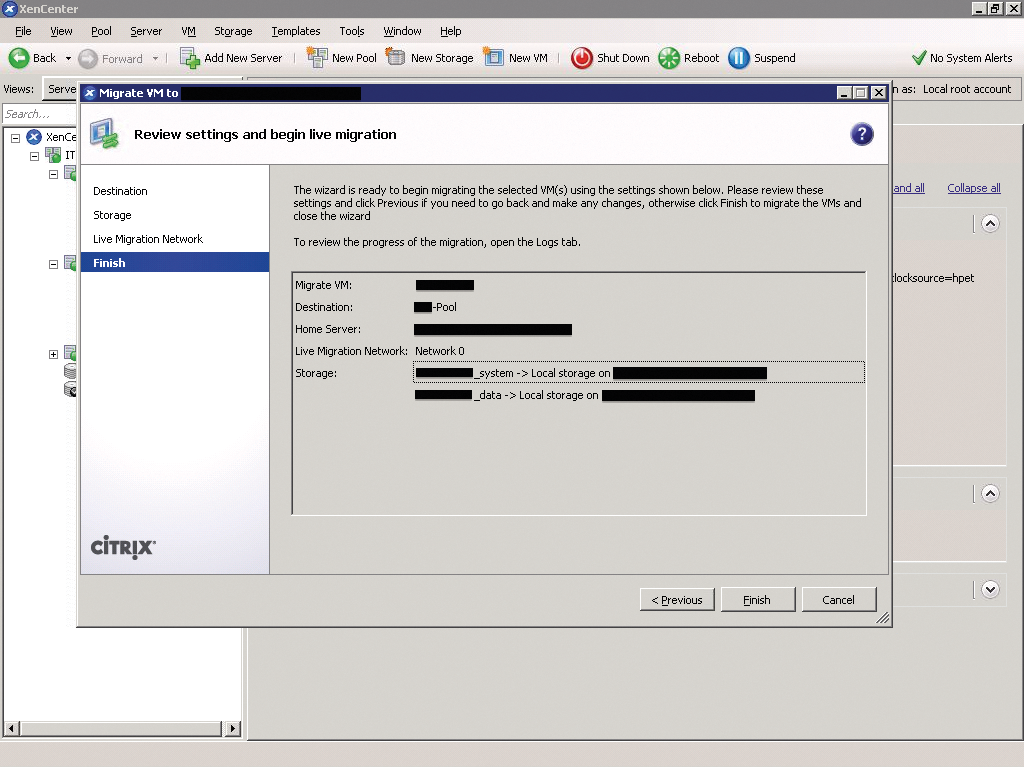
Citrix XenServer 6.2 goes open source
Free at Last!
Open source – finally and fully! The most interesting thing about the announcement [1] of the new XenServer version 6.2 is not a technical feature from the usual list of improvements: Citrix has released XenServer, its commercial product built around the open source Xen hypervisor, as free software. This bombshell make the manufacturer's previous Free, Advanced, Enterprise, and Platinum editions obsolete. For customers, there is only a single, free version that can do much more than the legacy Free Edition.
Taken Apart and Reassembled
Shortly after the release of the source code, the community began to decouple the components that define Citrix XenServer from the underlying Red Hat derivative operating system. The stated goal is to offer a XenServer core metapackage for as many Linux distributions as possible.
As the box "Xen, Libvirt, and Ceph" shows, this work has already been done for CentOS 6.4, and other distributions will follow. The concept for xenserver-core envisions three layers (Figure 1). In the near future, many prebuilt appliances will probably emerge that provide specially adapted images in the form of ISO image files. (Figure 2).


Citrix, however, has not just published the hypervisor and its management: The manufacturer simultaneously released the XenCenter Windows client, which enables simple graphical administration. The development of the components, which are licensed under the GPL, the BSD, and a proprietary Citrix license [4], will be continued in the future by the Xenserver.org community [5], while the manufacturer offers commercial support for those who need it.
Although Citrix boldly states that this free release was not a big surprise – after all, essential components such as the Xen hypervisor itself have been open source for a long time – it seems likely that the truth is a little different.
Farewell to Server Virtualization?
Xen, which was synonymous with virtualization on Linux for many years from 2003 onward, and at the time provided the only serious competitor to VMware, was originally developed at the University of Cambridge and commercially marketed by the company XenSource. It changed hands in 2007 for no less than US$ 500 million. The purchaser? Citrix.
A long series of releases has followed. For example, Citrix released the Xen Management API (XAPI) and the Xen Cloud Platform (XCP), a XenServer version that consists only of open source components in 2009. In 2011, free XAPI packages for Debian and Ubuntu were added. In 2013, XAPI and Xen.org were placed under the roof of the Xen project, which is now managed by the Linux Foundation.
Given that Citrix itself is not necessarily regarded as an open source sanctuary by the community, the whole situation reeks of an exit strategy from what is no longer a lucrative market, despite the tenor of recent announcements. Realistically, the move reflects the current enterprise virtualization market: KVM has caught up with Xen in many respects, often making it obsolete, even though turnkey solutions for corporate use are still lacking, except for Red Hat Enterprise Virtualization [6].
Nobody seems to be capable of threatening market leader VMware's position, and Microsoft Hyper-V is expanding its market share continuously, even in the cloud, which is otherwise traditionally occupied by Linux and OpenStack [7]. To make matters worse, the database giant Oracle also offers its own virtualization solution that is also based on Xen.
Even if XenServer was never a significant revenue generator for Citrix as a standalone product, but more of an add-on for the company's other products, it does offer a basic technology specifically for the XenDesktop Virtual Desktop Infrastructure (VDI). VDI provides virtual Windows desktops and is a revenue generator for Citrix. Because this tool works best with an efficient and customized hypervisor, it is a good idea for Citrix to keep interest in Xen on the boil – which obviously is exactly what it expects from this open source strategy.
Escape into the Cloud
Another potential area of application for XenServer is the cloud, Because most admins tend to build clouds on free distributions, the comprehensive Citrix release was the trigger for a feature-rich, flexible, and, above all, cost-effective alternative. However, admins who build their clouds on commercial distributions with appropriate support contracts need to look at the Citrix tools. If you want to host a Windows cloud, XenServer is a good and above all affordable alternative to Hyper-V.
XenServer – and many enterprise Linux distributions or VMware vSphere – has been certified under the Microsoft Server Virtualization Validated Program (SVVP [8]) for a number of versions. Thus, Windows customers who need an option for running virtualized servers can still receive full support from Redmond. Rackspace, for example, has been using XenServer for its Windows cloud [9] for some time.
Licenses and Consequences
In the course of the 6.2 release, Citrix changed the licensing model from a per-server to a per-socket model that costs $US 500 per socket per year. The price is roughly equivalent to that of the previous Enterprise Edition but now includes Subscription Advantage and premier support. These were options that customers previously had to purchase separately. Alternatively, Citrix offers a perpetual license for US$ 1,250, but customers do have to renew the contract for software maintenance every year.
If you previously had a server license, you can exchange this for a two-socket license. Whereas previous versions offered a different feature set depending on the license, the one version now available includes the full feature set.
Besides the benefit of being able to request support, the only feature that distinguishes the use of XenServer with or without a license is patch management with the XenCenter graphical client. If you have a license, you can automatically roll out hotfixes and security updates to a pool of hosts in the graphical interface.
Manual Update
If you are worried that an unlicensed XenServer installation will leave you standing out in the rain with regard to patches, you can stop worrying: You can still patch at the command line. This approach is not quite as elegant, but it still works and is fully documented by Citrix (see "Patching Without a GUI"). Note that mixed operations with licensed and unlicensed hosts in just one (resource) pool are not possible – the complete pool behaves as if it were unlicensed.
Technical Innovations
Along with the significant licensing changes, the new XenServer version also comes with a number of technical improvements, which are not particularly groundbreaking but are evidence of a continuous development of the product. For example, scalability has improved.
With appropriate hardware, up to 500 virtual machines running Windows, or 650 running Linux, is possible per host [11], making this enhancement a boost for desktop virtualization. The manufacturer also has extended the list of supported operating systems. Besides new versions of the major Linux distributions, Windows 8 and Server 2012 are now supported; this support was previously considered experimental.
The "Performance Monitoring Enhancements Pack for XenServer 6.1," which added RRD metrics to the legacy XenServer version and had to be installed manually, is now an integral part of the new version and offers much better insights into the I/O throughput. Figure 3 shows a brief overview of the selectable metrics for a hard disk. XenServer stores corresponding performance indicators for a year in an RRD database that discards the details over time. If you want to process the data with other tools, you need to convert using rrd2csv.

The new XenServer also includes a number of smaller improvements, such as support for new types of CPU, a PowerShell SDK revised for robustness, and optimizations that prevent DOM 0 from being taken down by excessive logging. Citrix also now uses a more recent version of the Xen hypervisor (v4.1.5).
Ditching the Ballast
Citrix has made a clean sweep and ditched some features in the current release that are obsolete in the opinion of the company, because they are not sufficiently widespread or because they have already found a worthy successor in the form of more successful competitors.
For example, friends of virtualized Solaris now have to look for a different platform. Additionally, Web Self Service has disappeared. This tool was a web interface that allowed users to control individual virtual machines assigned to them without having to have full administrative rights – almost a small cloud portal.
XenConvert, which was a tool for converting physical machines to virtual machines, has also been ousted. Additionally, because of a lack of demand, Workload Balancing (WLB) has been discontinued. WLB enabled decisions about the automatic placement of virtual machines on the basis of historical data and thus supported uniform load balancing across hosts.
Some people say that Citrix has removed more features from the latest version than it has added new features; the company says it is looking to reduce the package "to the essentials" in the future. Support for Microsoft System Center Virtual Machine Manager (SCVMM) is also being considered for removal
Despite these changes, the VMware competitor still includes all the features you would expect from a seasoned enterprise virtualization solution. The network can be teamed for failover and link aggregation, and dynamic memory allocation is supported. XenServer also supports a variety of storage back ends, all of which can be managed at the Xe command line or via a Windows GUI (.NET).
You can also easily deploy virtual machines for high availability. This feature made its way into XenServer 5 back in 2009 and originated with HA specialist Marathon. The HA function is quickly configured: The individual host systems with XenServer are first added to a common pool of resources, for which the administrator then activates the high availability. If you use the XenCenter interface and keep the default values, you can complete this process in significantly fewer than 10 clicks. To determine the state of the hosts in the pool, a heartbeat storage repository acts as a quorum that must be available to all hosts.
Next, you can select the restart strategy for the virtual machines in this resource pool, define non-critical hosts that are ignored if their host fails, and specify critical VMs that are restarted on another host. The automatic restart can, however, only be configured if the virtual machine is located on shared storage that all the hosts have access to, such as a central NFS share. Local virtual machines automatically restart on demand if their host comes back to life after a failure. A defined starting order is also possible (Figure 4). Other useful features let you move disk images around – across pool boundaries if necessary – thus allowing for far more flexible use of free resources.

Restart is grayed out because the VMs reside locally and thus cannot be restarted on another host.XenMotion
XenMotion, an option that lets you move virtual machines to a different host on the fly, even if the hosts do not use a common storage area, proves particularly useful in very small setups. It allows the admin – say, for cost reasons – to keep the infrastructure small and avoid expensive centralized storage (Figure 5). Moving to a different resource pool is also possible without interrupting operations [12]. However, machines on local disks cannot be restarted on another host in the event of a failure.

Focus on VDI and Virtual 3D Users
If you rely on virtual desktops with powerful 3D graphics performance, as is the case, for example, in CAD applications, you might want to pass through the performance of a powerful 3D graphics card to your virtual machine – this assumes enabling VT for direct I/O support in the BIOS. The whole thing is then known as "MultiGPU Pass-Through." Even if this setup reduces the virtual machine density per host (each guest exclusively reserves a GPU), you can consolidate high-performance desktops and far less demanding desktops on a single host.
Citrix seems to have realized that XenServer cannot be a jack-of-all-trades and is focusing on two core markets where it seeks to become the price-performance winner. First, the company is focusing on the VDI market, in which a hypervisor is optimized for high VM density and where Citrix offers special solutions for customers who require 3D performance, which they can then combine with their existing VDI environment.
Second, Citrix is targeting the cloud market, where having an open source hypervisor solution is clearly an advantage. Although XenServer builds on the open Xen hypervisor, on which a large percentage of cloud installations are already running, there are definitely some scenarios in which a solution with commercial support has a chance. In publishing its source code, Citrix has significantly improved its positioning and seeks to benefit from more input from the community.
Simple, Mature, Stable, and Good for Windows
If you have not yet embraced the cloud and are looking for an easy-to-use virtualization solution, the current version of XenServer is a useful choice. It gives you a working virtualization solution that is mature, fast, and stable and that compares well with competitors. XenServer offers many familiar features found in competitive products at a very attractive price.
